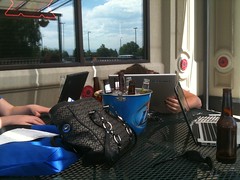 I remember when I worked for a large company and we were trying to come up with ways to maximize EBITDA -- my idea was to not renew our office lease; $90,000.00 direct to the bottom line by not really doing anything except not coming in to work. The idea, of course, was meet with resistance by a bunch of people, including people working in the office and people at the corporate office. What was interesting, of course, was that everyone already had laptops on their desk, all of the files were stored on servers in the corporate office, everyone had VPN access, and we had installed a very expensive phone system with IP and soft-phones; in short, we were totally set up to not be in the office, except no one wanted to be without the office.
I remember when I worked for a large company and we were trying to come up with ways to maximize EBITDA -- my idea was to not renew our office lease; $90,000.00 direct to the bottom line by not really doing anything except not coming in to work. The idea, of course, was meet with resistance by a bunch of people, including people working in the office and people at the corporate office. What was interesting, of course, was that everyone already had laptops on their desk, all of the files were stored on servers in the corporate office, everyone had VPN access, and we had installed a very expensive phone system with IP and soft-phones; in short, we were totally set up to not be in the office, except no one wanted to be without the office.Offices used to be where all the "stuff" was -- the computers, the servers, the phone system, the only way to check e-mail . . . that is no longer the case (do you remember when IT finally "turned on" Outlook Web Access) and it hasn't been for a while. It used to be that the only way the "watercooler conversation" happened was actually at the watercooler in the office, but now, of course, those conversations (and those that would likely never have occurred at the watercooler) take place on Facebook and instant messaging, faster and more dynamically and without having to get up from your chair.
Interestingly I compose this post from the patio of a place down the street that has wifi . . . because the power to our office complex is completely out and the power company is optimistic on the fact that it will be turned back on "at some point today". In the context of this post:
- Our e-mail and groupware services are through Google Apps -- wifi on the patio is as good as ehternet and wireless in the office.
- Our users store their files locally because they are constantly backed up and version-controlled when machines are idle for 10 minutes by Mozy Pro -- the file server is not a concern.
- The telephone/internet provider that we use allows us to software-forward the main office line to a cellular phone or other number if needed -- taken care of via a web portal.
- Most of our employees use their cell phones as their primary business phones anyway -- no disruption with the phone system being down.
- Our website is hosted with BlueHost.
- Our workforce management software is hosted and delivered via thin client.
- Our payroll system is hosted and delivered via thin client.
- We use Basecamp for a number of collaboration projects, but could easily scale it to a bunch of others -- Basecamp is hosted an accessible from anywhere.
- The only thing that we cannot reliably access is our accounting software, which is the only item that we continue to host on our server as opposed to in the cloud -- maybe I need to re-evaluate this.
Seth Godin has a more detailed and general post about offices that's worth reading: link. In his post, Godin describes the linchpin to the death of the office simply being the "place to go" -- this is by far the easiest piece. If you are a client service organization, and your client has a facility, go work there and meet there -- hopefully your client(s) like you and would be happy to see you and your team more often. Panera's had free wifi for as long as I've been going there; some of them even have cool lobby areas outside the store. Starbucks has free wifi starting in July; think of the coffee fees as your utilities (you'll probably get better productivity with everyone all cranked up on caffeine anyway). Invest in 3G/4G wireless cards -- 10 employees x $60 per month = $600 (how much is your rent and phone service monthly now? for that matter, how much is your T1 per month) and pick a cool place or places. Find a few places that are smart enough to offer wifi (see my post about this here) as part of their value proposition -- maybe negotiate a deal to be able to "put it on your tab" because everyone wants to feel like a regular somewhere and be able to say that to impress clients, employees, and prospective clients. Let your employees actually work from home sometimes -- you don't need to see them face-to-face to measure productivity; some of them will take advantage or freak out, but they're not the ones you want long-term anyway.
Is this scary stuff? Maybe. But why are you scared?
Perhaps more importantly: how much higher could your salary be if the company didn't have to pay rent and utilities and monthly charges at the office? How much would you save on your commute? How much more productive could you be if your face-time with your co-workers was finite every week?
Still scared?
PS -- I haven't been successful practicing what I'm preaching here . . . yet.
PPS -- In the picture she's not passed out on the keyboard, she's just hiding from the camera. But when's the last time your office looked like that?
Is this scary stuff? Maybe. But why are you scared?
Perhaps more importantly: how much higher could your salary be if the company didn't have to pay rent and utilities and monthly charges at the office? How much would you save on your commute? How much more productive could you be if your face-time with your co-workers was finite every week?
Still scared?
PS -- I haven't been successful practicing what I'm preaching here . . . yet.
PPS -- In the picture she's not passed out on the keyboard, she's just hiding from the camera. But when's the last time your office looked like that?


